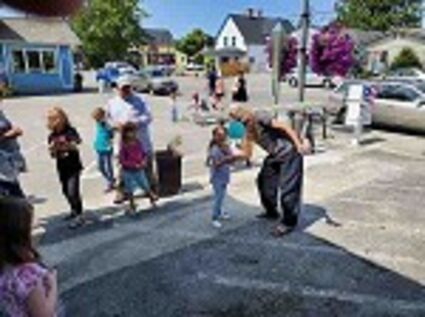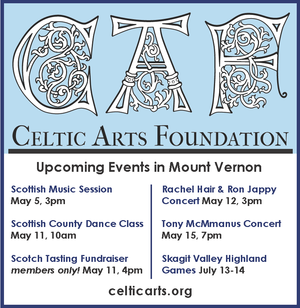Trial balloons pass library tests with flying colors
August 7, 2019

BARBER SCHOOL – Katrina Barber, La Conner Regional Library staff, shared a science lesson for children on Friday that was a cut above most. She used string, balloons, tape and an air pump to demonstrate elements of jet and rocket propulsion. The local library has been site of several activities this summer related to the 50th anniversary of the Apollo 11 lunar landing. -Photo courtesy of Bill Reynolds
The sky was the limit at La Conner Regional Library Friday.
And all it took was an air pump, balloons, string and tape.
Not the sort of technology one would expect at NASA or Space-X, but it was plenty enough for the Library’s Katrina Barber to introduce local children to the concepts of jet and rocket propulsion.
Barber attached string to a long ladder laid over sawhorses, and extended still more string up the side of the library building on Morris Street for a 45-minute program she tied to the 50th anniversary of the Apollo lunar landing.
Using those and other basic props suggested on-line, Barber was able to show the kids how to propel balloons horizontally and vertically, a home-made approach to simulating aircraft and rocket travel.
It was yet another of the local library’s summer series of children’s activities related to science and space exploration.
“I try to put fun into science,” Barber explained, “and tie it to the theme of going to the moon.’
Judging by the reactions from her budding group of aeronautical engineers, she succeeded on both counts. The kids never tired of seeing their balloons dart through the air.
Five-year-old Kaisa Carlson was among the first to launch a balloon up the library wall. Caitlin and Penny Delph followed soon after.
“That’s like rockets going in orbit,” Barber said.
Five-year-old Sig Carlson had earlier propelled his balloon several yards across the library parking lot to the ladder Barber had set up, mimicking the thrust needed for a jet aircraft to remain airborne.
“It probably took me about 10 minutes or so to rig everything up,” said Barber. “I’m just glad that we did this in the afternoon, when the sun was out and it didn’t rain. Can you imagine what this would’ve been like if we’d had to do it in the library this morning?”
It was a truly scientific process, with trial-and-error sometimes preceding successful launches.
“Do you think NASA has these kinds of problems getting their rockets launched?” Barber asked after a couple early duds.
Those setbacks were quickly remedied, and all systems were go from that point on.
Barber had begun the session by having kids take turns climbing into a cardboard box for others to slide on the library carpet. That was easy enough. But when the box was moved outside and onto cement, the weighted box was much more difficult to move.
“It took more muscles to move the box out here, didn’t it? asked Barber. “Your muscles are an energy source to move stuff.”
The next step was to show how air quickly depressed from a balloon can be a source of energy.
“The air comes out of a little space,” Barber told the kids. “That pushes the balloon.”
With only one air pump available, teamwork was the order of the day – as with any space flight.
“The kids were all good sports about it,” said Barber. “They all patiently waited their turns.”
Her lesson plan may have been linked to the moon, but Barber made it possible for each child to enjoy his or her moment in the summer sun.











Reader Comments(0)